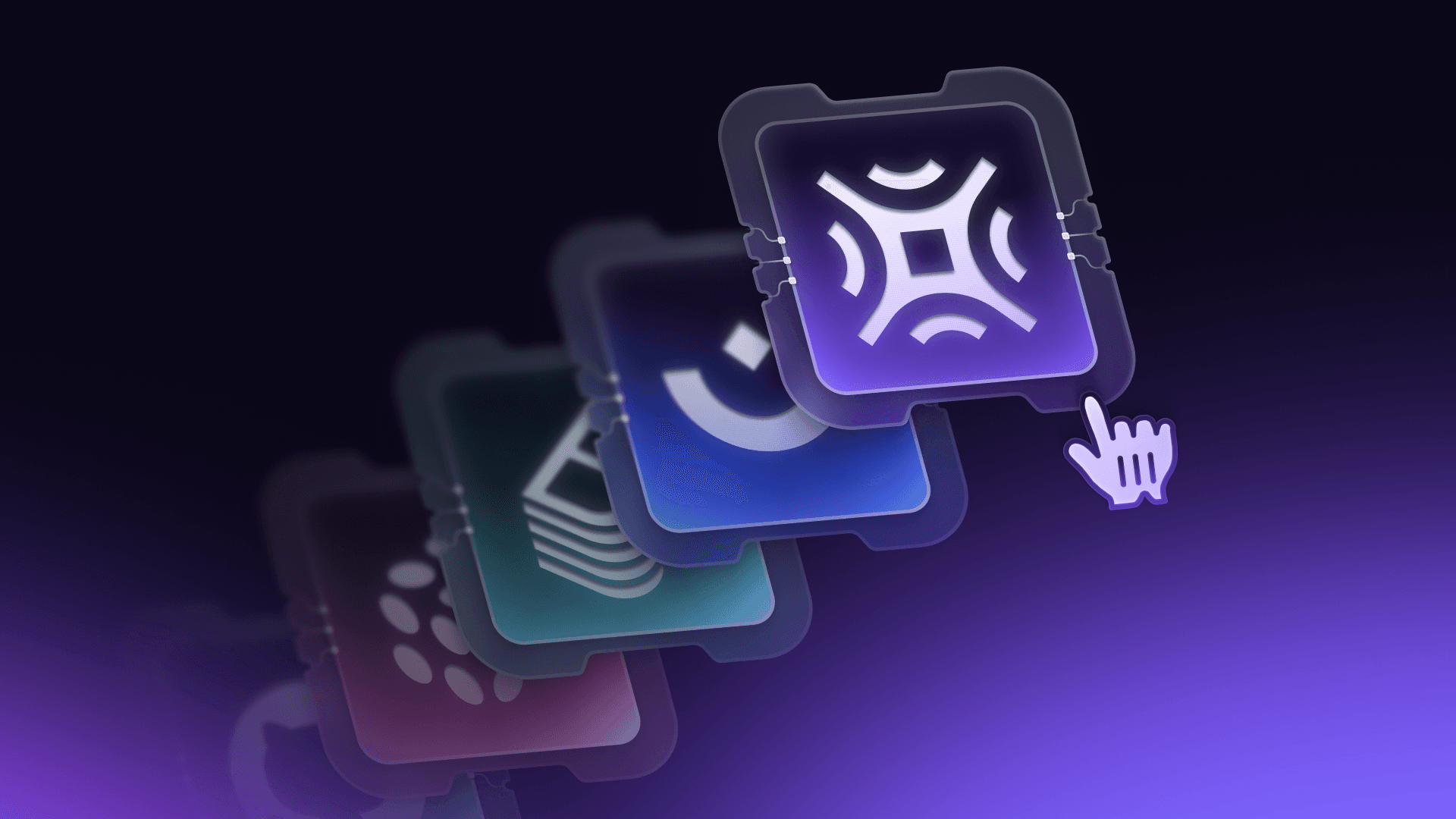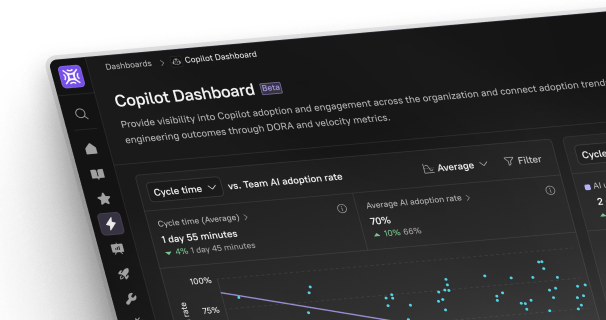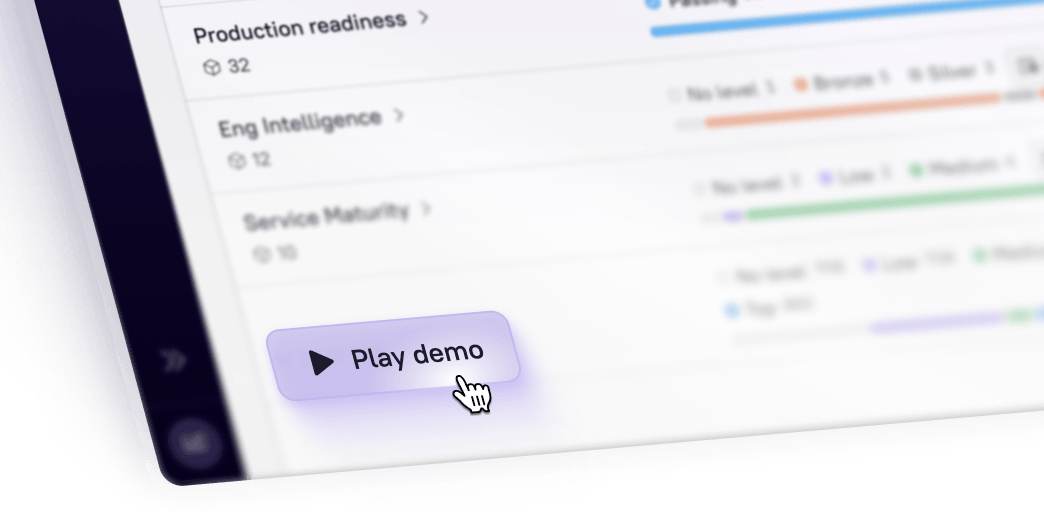Modern engineering teams are shipping more services, managing more complex infrastructure, and moving faster than ever. But this velocity often comes at a cost to the developer experience. Engineers are frequently bogged down by infrastructure complexity, inconsistent tooling, and a lack of clear standards, which leads to cognitive overload and slower cycle times.
This challenge has given rise to platform engineering, a discipline focused on creating a path to engineering excellence through consistency, velocity, and reliability at scale. This practice gives developers a set of well-defined, self-service tools to ship code quickly and safely.
In this guide, we'll break down what platform engineering tools are, why they matter, what features to look for, and how to choose the right one for your organization.
What are platform engineering tools?
Platform engineering tools are designed to help organizations build, manage, and scale their internal developer platforms (IDPs). They provide a centralized, self-service layer that abstracts away the complexity of the underlying infrastructure, allowing developers to focus on writing code instead of managing pipelines, environments, and configurations.
These tools are primarily used by platform engineers, DevOps teams, and engineering leaders responsible for developer enablement and productivity. They support the entire software lifecycle, providing workflows for everything from service creation and deployment to production readiness and observability. At their core, these tools are about improving the developer experience to drive better engineering outcomes.
Why use platform engineering tools?
Organizations typically adopt platform engineering tools in response to common pain points related to scale and complexity. Rather than focusing on the challenges that drive adoption, it's much more productive to frame the conversation around the benefits these tools provide.
Improve developer productivity and reduce cognitive load
In a complex microservices environment, developers are forced to context-switch constantly, toggling between different tools and dashboards just to get their work done. Platform engineering software reduces this friction by providing a single, unified interface for everything developers need, which reduces cognitive load and helps them stay focused on shipping code
Accelerate time-to-production with built-in standards
Platform teams can codify best practices for security, reliability, and compliance directly into developer workflows. Through automated checks, scorecards, and golden path templates, every service is validated against production readiness standards before deployment, reducing last-minute fire drills and rework.
Drive readiness, reliability, and consistency at scale
As engineering teams grow, it becomes difficult to ensure everyone is building and deploying software in the same way. Platform engineering solutions provide a centralized way to manage service ownership and enforce standards, replacing tribal knowledge with a consistent, reliable, and automated approach.
Key features to look for in platform engineering tools
The platform tooling market is crowded, and it's easy to get lost in the noise. To cut through it, focus on the core features that deliver the most value.
Service catalog and ownership tracking
A service catalog is the foundation of any internal developer platform. It answers critical questions like "Who owns this service?" and "Where is the documentation?" by providing a centralized, up-to-date directory of all microservices, resources, and their owners.
Scorecards and production readiness standards
Scorecards move teams beyond subjective measures of quality by providing objective, data-driven insights into service health. They allow platform teams to define, measure, and enforce production readiness standards in a consistent and automated way.
Golden paths, templates, and scaffolding
Golden paths and service scaffolders allow developers to create new services and applications in minutes, not weeks. These pre-defined templates ensure that every new service is built with best practices for security, compliance, and reliability from day one.
Self-service developer interfaces
A good developer portal provides an intuitive, self-service interface for common tasks like spinning up a new environment or provisioning a database. This empowers developers and removes the platform team as a bottleneck.
CI/CD, IaC, and observability integrations
A platform engineering tool should act as a connective tissue for your existing toolchain. Deep integrations with CI/CD pipelines, IaC tools, and observability platforms provide a unified view of the entire software lifecycle.
RBAC, policy-as-code, and compliance
These features are crucial for governance. They allow platform teams to enforce security and compliance policies automatically, ensuring that developers have the access they need without compromising on security.
Types of platform engineering tools
Not all platform engineering software serves the same function. The landscape can be broken down into several categories, and many teams build a cohesive stack by combining them.
Internal developer portals (IDPs)
Internal developer portals (IDPs) act as the single pane of glass for your engineering organization. They provide a unified interface for developers, integrating a service catalog, scorecards, and self-service actions to create a seamless developer experience.
Environment management / EaaS
These tools specialize in spinning up and tearing down ephemeral development and testing environments on demand. They are critical for enabling fast feedback loops and parallel development workstreams.
Infrastructure orchestration and IaC tools
Platforms in this category help manage and automate the provisioning of cloud infrastructure. They are the engines that power the self-service capabilities of a developer portal.
Workflow orchestration and automation
These tools are designed to automate complex engineering workflows that span multiple systems, from CI/CD pipelines to incident response playbooks.
Configuration and release management
Platform engineering solutions in this category help teams manage application configurations and control the release process, ensuring that deployments are safe, consistent, and repeatable.
While many teams combine tools from different categories, a platform that spans multiple functions, like an IDP, can significantly reduce tool sprawl and complexity.
10 best platform engineering tools to compare in 2025
Cortex
Cortex is an internal developer portal that helps engineering teams drive consistency, quality, and velocity. It provides a single pane of glass for all microservices, combining a comprehensive service catalog with powerful scorecards that measure production readiness and enforce standards. Cortex acts as the connective tissue in a modern engineering organization, integrating with the entire DevOps toolchain to provide visibility and control.
Key Features: Service Catalog, Scorecards for governance, Scaffolder for new services, robust integrations with CI/CD, observability, and IaC tools.
Best For: Teams looking to establish and enforce engineering standards at scale, improve service quality, and reduce developer cognitive load. Cortex is trusted by high-growth startups and large enterprises alike.
Spotify Backstage
Spotify Backstage is an open-source framework for building internal developer portals. It helps teams create a centralized place for their infrastructure tooling, software components, and documentation, improving developer onboarding and service discovery.
Key Features: Software Catalog for managing all services, Software Templates for creating new projects with best practices, and a rich ecosystem of open-source plugins.
Best For: Organizations with dedicated platform engineering teams that have the resources to build, customize, and maintain their own developer portal.
Humanitec
Humanitec is a platform orchestrator that enables teams to build developer workflows. It uses a dynamic configuration management system to help platform engineers create reusable templates for infrastructure and application deployment.
Key Features: Platform Orchestrator for dynamic configuration management, self-service environment provisioning, and RBAC.
Best for: Organizations looking to standardize their application configurations and deployments to accelerate developer velocity.
Coherence
Coherence is a developer platform focused on cloud infrastructure and development environments. It provides tools for building, testing, and deploying full-stack applications with ephemeral environments and cloud management features.
Key Features: Ephemeral environments as a service, automated cloud provisioning, and Cloud IDE support.
Best for: Teams that want to abstract away infrastructure complexity and standardize their cloud operations.
Crossplane
Crossplane is an open-source Kubernetes add-on that extends a cluster to manage and provision infrastructure, services, and applications from a single control plane. It enables platform teams to build their own custom cloud-native APIs using kubectl.
Key features: Manages external resources from Kubernetes, provides a universal API for cloud services, and allows for the creation of custom infrastructure abstractions.
Best for: Teams heavily invested in the Kubernetes ecosystem that want to use its declarative API model to manage their entire cloud infrastructure.
Terraform
Terraform by HashiCorp is an industry-standard Infrastructure as Code (IaC) tool. It allows teams to define and provision cloud and on-prem resources using a declarative configuration language. While not an IDP itself, it is a foundational integration for nearly every platform engineering tool.
Key features: Declarative configuration files, execution plans to preview changes, and a graph-based view of infrastructure dependencies.
Best for: Any organization managing infrastructure in the cloud. It is the engine that often powers the self-service actions within a developer portal.
Pulumi
Pulumi is an Infrastructure as Code (IaC) platform that lets teams define and manage cloud infrastructure using familiar programming languages like TypeScript, Python, and Go. This approach allows for greater flexibility, abstraction, and the use of standard software development practices like loops and functions.
Key features: Use general-purpose programming languages, robust state management, and tight integration with CI/CD systems.
Best for: Teams who prefer to manage infrastructure with the same languages and tools they use for application development.
Kubernetes
Kubernetes is an open-source container orchestration platform that automates the deployment, scaling, and management of containerized applications. It serves as the foundational layer for running modern cloud-native applications at scale.
Key features: Automated orchestration, service discovery, self-healing, and load balancing.
Best for: Organizations that need to automate microservice deployments at scale across cloud or hybrid infrastructure.
GitHub Actions
GitHub Actions provides workflow automation directly within the GitHub platform. It allows teams to build, test, and deploy code from within their repositories. For platform engineering, it's a critical integration point for triggering automated workflows and providing visibility into build and deploy statuses within a developer portal.
Key features: Deep integration with GitHub, a marketplace of pre-built actions, and hosted runners for major operating systems.
Best for: Teams that want a tightly integrated CI/CD and source code management experience.
HashiCorp Vault
HashiCorp Vault is a tool for managing secrets and protecting sensitive data. It provides a secure, centralized place to store and control access to tokens, passwords, certificates, and encryption keys. For platform teams, Vault is a critical dependency for building secure golden paths and developer workflows.
Key features: Secure secret storage, dynamic secrets, data encryption, and identity-based access control.
Best for: Any organization that needs to manage secrets and credentials for applications and infrastructure securely.
Datadog
Datadog is a monitoring and observability platform that provides visibility across the entire stack. It aggregates data from servers, containers, databases, and third-party services to make infrastructure and application performance fully observable. IDPs like Cortex integrate with Datadog to display relevant metrics and alerts directly in the service catalog.
Key features: Infrastructure monitoring, APM, log management, and security monitoring in a single platform.
Best for: Teams that need a unified view of their application performance, infrastructure health, and security posture.
How to choose the right platform engineering tool
Choosing the right tool depends on your organization's specific needs and maturity.
Define your goals and team maturity
Start by identifying the primary pain point you want to solve. Are you focused on developer onboarding, production readiness, or CI/CD automation? A newer platform team might prioritize scaffolding, while a more mature team may need advanced governance features.
Evaluate feature set and developer fit
Once you have a goal, evaluate tools based on the features that will help you achieve it. Most importantly, ensure the tool is one your developers will actually enjoy using; otherwise, you'll struggle with adoption.
Check integration and extensibility
Your platform tool must integrate seamlessly with your existing technology stack. Look for flexible APIs and a wide range of pre-built integrations to ensure you can connect to the tools your team already uses.
Compare time-to-value and cost
Consider the total cost of ownership, not just the sticker price. A tool that is quick to implement and easy to maintain may provide a faster return on investment than an open-source solution that requires significant engineering resources.
Review case studies and proof points
Look for success stories from companies that are similar in size and industry to yours. This will give you a good indication of how the tool will perform in your own environment.
Learn more about Cortex
Cortex is built to solve the core challenges of scale, complexity, and developer productivity. By providing a unified platform for managing services and enforcing standards, Cortex offers a faster, safer path to production for teams at high-growth companies and enterprise organizations.
Ready to see how it works? Book a demo or try it now.





